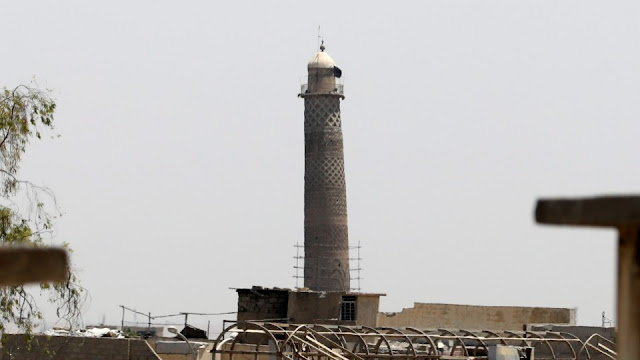From TRT World
Daesh is accused of blowing up the Grand Al Nuri Mosque, where the terrorist group's leader Abu Bakr al Baghdadi proclaimed himself "caliph" in 2014.
Daesh blew up the Grand Al Nuri Mosque of Mosul and its famous leaning minaret on Wednesday, the Iraqi military said, as government forces seeking to expel the group from the city closed in on the site.
It was from this centuries-old mosque that Daesh leader Abu Bakr al Baghdadi in 2014 declared a self-styled "caliphate" spanning parts of Syria and Iraq three years ago.
''Blowing up the Al Hadba minaret and the Al Nuri mosque amounts to an official acknowledgement of defeat,'' Iraqi Prime Minister Haidar al Abadi said.
TRT World spoke to Ammar Karim who has more on the story from the capital Baghdad.
The Iraqis called the 45-metre (150-ft) leaning minaret Al Hadba, or "the hunchback." Baghdadi's black flag had flown over it since June 2014.
The terror group's Amaq news agency accused American aircraft of destroying the mosque. The US-led coalition fighting the group denied the claim.
"We did not strike in that area," coalition spokesman US Air Force Colonel John Dorrian said.
"The responsibility of this devastation is laid firmly at the doorstep of ISIS [Daesh]," said US Army Major General Joseph Martin, commander of the coalition's ground component in Iraq.
Battle in the Old City
The Iraqi military's media office distributed a picture taken from the air that appears to show the mosque and minaret flattened in the middle of the small houses of the Old City, the historic district where the remnants of Daesh in Mosul are under siege.
"The Daesh terror gangs committed another historical crime by blowing up the Al Nuri mosque and its historical Al Hadba minaret," the Iraqi military said in a statement.
| Daesh leader Abu Bakr al Baghdadi speaking from the Grand Al Nuri Mosque in Mosul, June 2014. (AP) |
The mosque was destroyed as Iraq's elite Counter Terrorism Service (CTS) units, which have been battling their way through Mosul's Old City, got within 50 metres (164 feet) of it, according to the statement.
An Iraqi military spokesman gave the timing of the explosion as 9:35 pm (1835 GMT).
Government forces on Tuesday encircled the group's last stronghold in Mosul's Old City district.
On Wednesday, they said that they started pushing toward the mosque.
''This will not prevent us from removing them, no, killing them not removing them, inside the Old City,'' Lieutenant General Abdul Ghani al Assadi, senior CTS commander in Mosul, said.
Iraqi officials had privately expressed hope that the mosque could be captured in time for Eid al Fitr, the festival marking the end of the holy Muslim fasting month of Ramadan. The first day of Eid falls this year on June 25 or 26 in Iraq.
The fall of Mosul would, in effect, mark the end of the Iraqi half of the "caliphate" even though Daesh would still control territory west and south of the city, the largest swathe of land they still control, in Iraq or Syria.
History wiped out
The Grand Al Nuri Mosque is named after Nuruddin al Zanki, a noble who fought the early crusades from a fiefdom that covered territory in modern-day Turkey, Syria and Iraq. The mosque was built in 1172-73, shortly before his death, and housed an Islamic school.
By the time renowned traveller Ibn Battuta visited two centuries later, the minaret was already leaning. Its tilt gave the landmark its popular name, "al Hadba", or the hunchback.
The mosque was built with seven bands of decorative brickwork in complex geometric patterns ascending in levels towards the top in designs also found in Persia and Central Asia.
Nabeel Nouriddin, a historian and archaeologist specialising in Mosul and its Nineveh region, said the minaret has not been renovated since 1970, making it particularly vulnerable to blasts even if it was not directly hit.
The Mosque's destruction occurred during the holiest period of Ramadan, its final 10 days. The night of Laylat al Qadr falls during this period, marking when Muslims believe the Quran was revealed to the Prophet Mohammed.
Daesh has destroyed many Muslim religious sites, churches and shrines, as well as ancient Assyrian and Roman-era sites in Iraq and in Syria.
The group posted videos online in 2015 showing the destruction of artefacts in the Mosul museum, some of which dated from the 7th century BC. It is also suspected of selling artefacts to finance their war.


Comments
Post a Comment